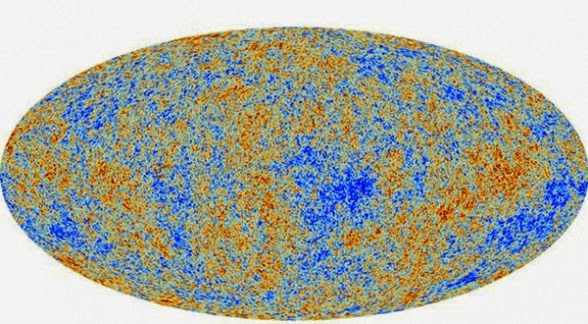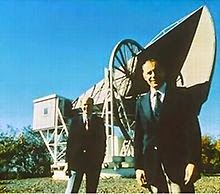All Things
The same post in Spanish
- The Final Anthropic Principle And The Antichrist
Pierre Teilhard de ChardinIn their popular science book, The Anthropic Cosmological Principle, published in 1986, cosmologists John Barrow and Frank Tipler define three different anthropic principles:1. The weak anthropic...
- The Scientific Work Of Stephen Hawking
The scientific work of Stephen Hawking has been quite productive, although the media, influenced by his sad personal situation, tend to exaggerate its importance, putting him sometimes at the level of Einstein. His most renowned works are the following:The...
- The Fine Tuning Problem
In two previous posts I dealt with the relation between the multiverse theories and the problem of fine tuning, noting that those theories do not solve the problem. This third post describes briefly what is the fine tuning problem. Brandon CarterIn 1973...
- The Multiverse Does Not Solve The Fine Tuning Problem
Atheists use the multiverse theories to escape the need to accept God?s existence as the cause of a universe which seems to have been designed to make life possible (fine tuning). While they do this, they are contradicting one of their most beloved arguments...
- The Probability Of Existence Of Extra-terrestrial Intelligence
Normal statistical distribution. The text makes reference to a uniform statistical distribution.Probability is a well-known mathematical concept that was initially defined to quantify random data in mathematically known environments and has been extended...
All Things
A photograph from the abyss of time
 |
| The cosmic background radiation as detected by the Planck satellite telescope |
When the space telescopes sent by NASA and the European Space Agency (COBE, WMAP, Planck) send us data on the cosmic background radiation, the corresponding images usually appear on the first page of high-diffusion newspapers, accompanied by headlines that are not always correct. Let's look at a few, published in Spanish newspapers:
- A radiation coming from infinity (La Vanguardia, April 28, 1992). This headline is clearly exaggerated, as the cosmic background radiation does not come from infinity, but from about 40,000 million light-years away.
- A telescope that gets back to the origin of the universe (El País, March 21, 2013). This is not true: when we measure the temperature of the cosmic background radiation, we are not getting back to the origin of the universe, but to a few hundred thousand years after that origin.
- The Planck space telescope reveals an older universe (www.gistain.net, March 21, 2013). This is not accurate: the Planck telescope did not reveal an older universe than previous telescopes, just increased the precision with which the details of the cosmic background radiation are known, but the age of the detected signal was exactly the same.
- The Planck telescope shows the first lights at the origin of the universe (La Gaceta, March 21, 2013). This headline is almost right. If it had said The Planck telescope shows the first lights near the origin of the universe it would have been fully right.
- The Planck Space Telescope captured the first light of the universe (La Vanguardia, March 21, 2013, La Razón, March 22, 2013). This is the only right headline in this sample.
 |
| Wilson and Penzias near the radio-telescope antenna |
Indeed, the cosmic background radiation is the residue, reduced by the expansion of the universe, of the first light that could go across the cosmos when it became transparent, several hundred thousand years after the Big Bang. The discovery of this radiation earned Arno Penzias and Robert Wilson the 1978 Nobel Prize in Physics and made the Big Bang the standard theory about the origin of the cosmos.
The existence of the cosmic background radiation was suggested in 1948 by Ralph Alpher and Robert Herman. After the Big Bang, while the temperature was above 3000K, electrons could not associate with protons to form hydrogen atoms. All matter was in the plasma state, the same as inside the sun. It was therefore opaque. When the temperature dropped below 3000K, atoms were formed, so matter passed to the gaseous state and became transparent. Since that time, the light from other parts of the universe can reach us.
The cosmic background radiation is the endpoint that our telescopes can reach. Beyond that we cannot see, because the universe becomes opaque and does not let the radiation through. To study the first half million years of the history of the universe (more or less), we may solve some mathematical equations and make predictions about processes that might have happened using particle physics, but we cannot see those processes directly, except by looking for traces of these phenomena in the cosmic background radiation.
Manuel Alfonseca
- The Final Anthropic Principle And The Antichrist
Pierre Teilhard de ChardinIn their popular science book, The Anthropic Cosmological Principle, published in 1986, cosmologists John Barrow and Frank Tipler define three different anthropic principles:1. The weak anthropic...
- The Scientific Work Of Stephen Hawking
The scientific work of Stephen Hawking has been quite productive, although the media, influenced by his sad personal situation, tend to exaggerate its importance, putting him sometimes at the level of Einstein. His most renowned works are the following:The...
- The Fine Tuning Problem
In two previous posts I dealt with the relation between the multiverse theories and the problem of fine tuning, noting that those theories do not solve the problem. This third post describes briefly what is the fine tuning problem. Brandon CarterIn 1973...
- The Multiverse Does Not Solve The Fine Tuning Problem
Atheists use the multiverse theories to escape the need to accept God?s existence as the cause of a universe which seems to have been designed to make life possible (fine tuning). While they do this, they are contradicting one of their most beloved arguments...
- The Probability Of Existence Of Extra-terrestrial Intelligence
Normal statistical distribution. The text makes reference to a uniform statistical distribution.Probability is a well-known mathematical concept that was initially defined to quantify random data in mathematically known environments and has been extended...
